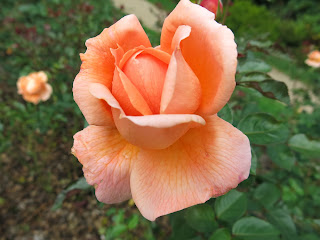We first spent some time at the Louvre. I need to see the Louvre in small pieces. It
is huge- and takes a lot of time to get from one section to another. Plus it is
always crowded.
My first stop today was the Venus de Milo. An example of the crowds around one of their most famous works.
Here is a statue of Aphrodite, by Praxiteles, the Athenian
sculptor who invented the female nude. I
had never thought about the fact that someone had to be the first one to sculpt
a nude female until I saw this bit of information about him.
Next, a statue of Athena, the female warrior goddess who was
the patron of Athens. The original statue was created in 430 BC.
Next, some fragments from the original Pantheon. A scale model of the Pantheon is on
exhibit. Having seen the Pantheon in
Paris, it is now clear to me where the
inspiration came from.
An old Roman statute from the Borghese collection.
At first you wonder why these four men in a circle are looking at themselves so intently. Then you read the plaque and realize that they originally held up a fountain.
Next, I met up with Al, who had found the wall which had
surrounded the original Louvre when it was a fortress. This is all in the basement of the Louvre. They have a model of the original
Louvre.
This is a bird's eye view with the original fort/castle in the middle. You can see the tower inside the walls and the surrounding city. This is now under the east end of the Louvre, which has been expanded by subsequent kings on top of this fort/castle and to the left or west. North is at the top of the model. You can see a bit of the Seine at the very bottom of the model.
This shows the floor plan of the existing part of the original fort. The path starts in the upper right and you walk down the rights side, then the bottom and then through the middle around the foundation of the original tower. All of this is under the Louvre and is about two stories tall.
This is the view standing in the bottom right corner of the diagram looking back towards the entrance. The wall on the right is part of the outer wall of the fort/castle. The wall on the left is part of the inner keep. You can see the rounding of the corner tower.
This is looking at a 90 degree angle from the previous photo along the part on the bottom of the diagram. The wall on the left is the outer wall of the fort/castle. The part on the right is the wall to the inner keep. You can see the round part of the same corner tower as shown in the previous photograph.
This is inside the keep. The wall on the right is the keep wall. The wall on the left is the round tower in the middle of the fort/castle.
Also, inside the keep. The keep wall is on the left. The central tower is on the right.
This is another part of the original fort/castle that appears to have been a storage room. Obviously, the part of the original fort/castle that is above this level is gone and has been replaced by the buildings of the Louvre. Essentially, these structures exist in the basement of the Louvre and support the present day building.
Next, on to Château de Vincennes. Vincennes is the fortress built by
Charles V during the 14th Century. He hated Paris, and this location was in the
country at that time. It was first a hunting lodge, and later turned into a chateau and fort. (Today, it is at
the end of Metro line #1). He built
himself a substantial fortress- double walls, moat, all sorts of defense
tools, towers for guards.
Entrance with drawbridge
The keep. It has the tallest medieval tower in Europe. It now houses a museum for the history of the armies of France.
Detail of inside wall of the keep
Moat in the keep
Entrance with drawbridge
The keep. It has the tallest medieval tower in Europe. It now houses a museum for the history of the armies of France.
Detail of inside wall of the keep
Moat in the keep
This is the chapel for the Chateau. They built big in those days.
The old hunting grounds are now the second largest park in Paris. This is looking back towards the chapel from the park.
Lots of small streams.
Men playing pétanque. It is very similar to bocce ball.
Lots of trails through the woods for walking, bicycling, and horseback riding.
.

Pictures of the lake.
A lot of pretty flowers
This small park is outside the main area, near the subway stop. I suppose it would be their Vietnam Memorial.
There is an art museum by the subway stop also that has this swimmer in its front yard.














































No comments:
Post a Comment